Photo: Paul Rudderow
Who: Philadelphia Union at Chicago Fire
What: Regular season game
Where: Toyota Park
When: Saturday, April 2 at 5 pm
Watch: TCN, MLS Live, Direct Kick
Whistle: Silviu Petrescu; Linesmen: Phil Briere, Gianni Facchini; Fourth Official: Kevin Terry Jr.
Philadelphia Union travel to Chicago aiming for three wins in a row. After beating two teams that want the ball, the Union face a different challenge in Veljko Paunovic’s Fire. And after giving up three goals in the first half they played this season, the former Union man’s young squad has only allowed one in their last five halves. This is no fluke: The Fire, using an innovative 3-5-2, have closed up shop in a sustainable way. Unfortunately, their offensive effectiveness makes the 76ers look dangerous.
In contrast, the Union have had no trouble pouring in the goals, but the last counterattacking team they faced stomped them into the Frisco turf. To be clear, the Fire are not on Dallas’ level, but they aim to do many of the same things as the Western Conference champs going forward. Make no mistake: Philly is the better team. But the Fire are also vastly improved since last season.
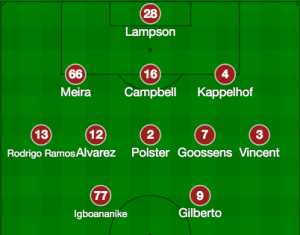
In reality, the CBs are far closer and Polster drops deeper to protect. But the wingbacks really do want to get that high.
Campbell and company
Paunovic has introduced a modern 3-5-2 system that can flexibly become a 5-3-2 or a 3-4-1-2. Ironically, the Fire drafted the highest rated left back in a generation and… deployed him as an Italian wingback. The aim of the three-man backline is to use the wide backs to create numerical advantages at each line moving forward. With the ball, the wingbacks move far up the pitch, much higher than traditional fullbacks but just as wide.
Rookie Jonathan Campbell plays in the middle of the back three and moves the ball to one side where Joao Meira and Johan Kappelhof advance towards the midfield. The goal is to push past the striker line and pull a midfielder to the ball so the opposition is left with four defending five. Furthermore, using two strikers means one can run behind the fullbacks when they step to the Fire’s wingbacks with a target man remaining in the middle.
It has worked so well defensively because Campbell has proved an increasingly confident organizer and Meira and Kappelhof have been mobile enough to cover for the fullbacks. One of the interesting benefits of a three-man defense is that it keeps the central player — in this case, Campbell — right smack in the center of the pitch.
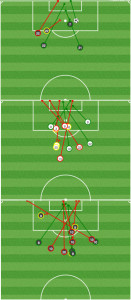
Chicago shots conceded. Not a lot from good positions (top: NYC 2nd half, center: Orlando City, bottom: Columbus)
This makes it very difficult to attack Chicago up the middle, and extremely difficult to create shooting opportunities directly at goal. Columbus found early success by pulling Kappelhof (playing to Campbell’s left) wide and running into the channel he left behind (see gif below). However, this success was tempered by the Crew’s inability to figure out what to do in the box. They were in close, but often at tight angles. And the Fire’s defense dropped quickly so they were not retreating and chaotic enough for Kei Kamara to sneak into space.
So there are holes to be attacked, but Chicago has started loose and become more structured in each of their first three matches. Sure, they have done it by sacrificing the linking player to their strikers (Goossens drops deep to clog the middle), but it is clear they are improving their defensive chemistry with each match. Surrounding Matt Polster with a pair of energetic ball hounds and the second year man is able to sit in something of a safety role that allows him to read and disrupt plays. Polster is very, very good at this.
Trouble going forward
However, Polster, along with Vincent, are still struggling with the nuances of how to attack in this new system. To be fair to the US U-23 man, his compatriots in the center have not made things easy. Against Columbus, Arturo Alvarez and John Goossens checked short and square far too often, making it easy for the Crew to cut passing lanes to the strikers. The two mids playing in front of Polster need to be moving in order to open the tollbridge to the front men.
But the bigger issue is that the Fire midfielders still play like a traditional three-man midfield. They like short passes, find a wide player when they need an outlet, then check short and collect the ball. And that does not seem like the best way to use Chicago’s shape.
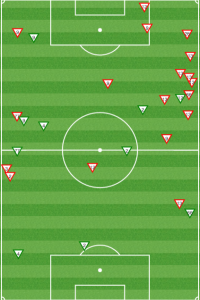
Chicago successful (green) and unsuccessful (red) dribbles vs Columbus. Ramos got into some tight quarters on the right. Vincent didn’t get far enough up the pitch to receive the ball.
The 3-5-2 that Paunovic seems to favor is reminiscent of Antonio Conte’s Juventus and Italy sides in all but how they start attacks. Italy lets the center backs attack a defense through the channels or plays long, crossfield passes to the wingbacks who advance the ball quickly and pull a defensive line apart. Chicago, in contrast, plays the ball slowly as they advance up the pitch. Furthermore, they seem to favor quick give-and-goes between midfielders and wingbacks in the middle third, long before the wingback is asking questions of the opposing fullback. The result is a team that spends a lot of time trapped against the touchline and very little time in the final third.
Paunovic’s next big challenge is figuring out how to add offensive spark to defensive solidity. And solving this dilemma means he has likely focused on two areas of the pitch in the leadup to the Union match: The strikers and the left flank.
These are not the strikers you are looking for
David Accam is very, very fast. But that downplays a less tangible skill that separates him from a guy like Dom Oduro. Accam is a sneaky runner, and for a guy playing on a team without much creativity, he does an incredible job of finding his own space.
Luckily for the Union, Accam is unlikely to be healthy enough to go the full ninety on Saturday. In their talisman’s stead, the Fire will rely on Gilberto and Kennedy Igboananike, two guys who rarely end up sharing a sentence with the word ‘rely’ unless they also share it with ‘don’t’.
Both Chicago strikers can be potent in good areas, but neither has shown the ability to create their own opportunities or pull a defense out of position. This is particularly disturbing in Igboananike’s case. The Nigerian front man has many qualities of a solid MLS striker, but simply cannot create separation because he reacts to play rather than dictating it by moving into channels and checking deep to move defenders around. As a result, Igboananike has been a very poor man’s David Accam during his short stay in Chicago: A speedster who relies on a tired or error-prone defense for his lunch.
Gilberto is a more interesting case because he can add a creative spark when he gets on the ball. Thus far, however, the Fire have not been able to hold the ball in the final third for any length of time that would allow the Brazilian to camp in good spots and play in runners. These situations bring out Gilberto’s best, while running the channels is something he does mostly in reaction to play, not in advance of it.
Against the Union, Chicago needs to create big gaps between the fullbacks and central defenders if they want to get the most out of their strikers. This means forcing the Union’s fullbacks to step to the Fire’s wingbacks so Igboananike and Gilberto can provide outlets into the corners and bring the rest of the squad forward with them. Concurrently, this should open space in the center for John Goossens, who has been a linking player in name only through three matches.
That fullback plays wingback like… a fullback
On the left, Paunovic is still working with the talented but raw Brandon Vincent on wingback positioning. Vincent can get forward as a fullback, but he is not the flying-up-the-flank type. And that conservatism has been amplified as he learns how to interpret the wingback role while adjusting to the speed of MLS. Vincent’s progress can be contrasted with Rodrigo Ramos on the right. Every time Chicago controls the ball in back, Ramos is immediately even with, if not above, the midfield line, pinning the opposition winger back to give Meira space to advance the ball.
[gfycat data_id=”LankyChiefGrayling” data_autoplay=false data_controls=false data_title=true]
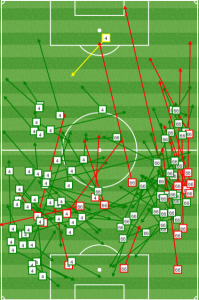
Kappelhof (4) has to make passes from a deeper, more central position than Meara (66) because Vincent on the left often stays deeper than Ramos on the right.
Vincent, in contrast, stays a bit behind the midfield line, or moves up to it as Kappelhof advances. When Vincent does get upfield (as you can see above), it allows Kappelhof to advance into the middle third unfettered. If Vincent is deeper, it means the defense is closer to Kappelhof as he moves forward, and if the defender plays the ball vertically into midfield, Vincent is not in position to provide an immediate outlet and move the ball into the final third, which is what the wingbacks should be doing in this system. Look for Vincent to try and establish early position high up the pitch to pin Ilsinho deep. If he doesn’t, Chicago will likely become very right-sided. Against Columbus, you can see how Kappelhof passed from a more central position than Meira because the wide defense was positioned higher up the pitch. As the Crew adjusted to the Fire’s one-sided attack, Meira was forced to play long more often, and the Fire quickly ran out of attacking ideas.
Another interesting quirk of the Fire’s offense has been the strange dedication to playing give-and-goes with the wingbacks. This is almost exactly the opposite of what you would expect a 3-5-2 to try and do. By pushing the wingback high, you force the defense to collapse on that area of the pitch, hypothetically opening up space in different areas. Yet, Chicago has been insistent upon getting the ball to the wing, inviting pressure, playing the ball centrally… then putting it right back into pressure. Meanwhile, the opposite flank is emptier than a bottle of tequila at a PSP staff party. If the Fire start to switch the ball quickly across the middle third, the Union — and the rest of the league — will face a much tougher opponent.
[gfycat data_id=”WigglyIncredibleDassie” data_autoplay=false data_controls=false data_title=true]
Union attack
For the Union to control the match, they need to be able to play quickly in transition and keep CJ Sapong on the outside central defenders rather than Campbell. A transition that attacks the center through the flanks can be deadly against a 3-5-2 because it gets behind the wingbacks and pulls central defenders wide. Columbus moved the ball too slowly (as they did against Philly) to attack the Fire effectively in wide areas (the Crew really need to consider switching wide players for short periods of the match going forward. Finlay would’ve feasted on the space behind Ramos).
[gfycat data_id=”DistinctExemplaryBlackfootedferret” data_autoplay=false data_controls=false data_title=true]
Second, Philly needs to be patient in the final third. Once the Fire establish defensive shape, they have a line of five in the back and Polster sitting in front of a tight defensive trio in the center. Since that absurd first half against New York City, nobody has been able to effectively penetrate the middle against Chicago. Instead, the best chances come through runs between central defenders followed by low crosses or cutbacks. Traditional crosses into the box are extremely difficult to convert with all three of the Fire’s defenders in position. Either get behind the defense and attack from the wing (Ilsinho’s approach) or attack with speed and angled throughballs that put Pontius in behind Ramos.
Lineup questions
With Vincent Nogueira and Tranquillo Barnetta back in the mix, Jim Curtin has big decisions to make in his starting eleven. Brian Carroll and Warren Creavalle have been strong, but when you can call on a Swiss international and the best possession player on the roster… how do you say no?
There is, actually, a fairly good argument for keeping Philly’s top two midfielders sidelined. After traveling to Chicago, the Union have a short week before facing Orlando City in Chester, then it’s on to Seattle before three straight difficult home games. In the big picture, a draw on the road against the Fire is not a terrible outcome. And it is certainly not as bad as losing Barnetta or Nogueira for significant time because they came back too early. It may be a case of working the duo back in at home, then potentially giving them a longer rest by keeping them off the notoriously bad Seattle turf.
So the Union will likely trot out a similar lineup to the one that suffocated New England, with Barnetta potentially working in on the right or through the middle. Leaving Nogueira out is a difficult call, but Warren Creavalle’s ability to turn midfield pressure up a notch will be valuable against a Fire squad that has yet to develop a quick passing game to bypass a high press.
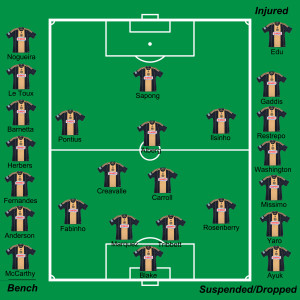
Difficult to say who gets dropped from the 18 with Nogueira and Barnetta back
Prediction: Union 1-0 Fire
I can easily see this being a dour, goalless draw. And it will certainly get very interesting if Chicago grabs an early goal and sits on its laurels, because the Union haven’t faced a team that sat deep and absorbed pressure yet and it’s questionable whether they can break one down. Union fans should hope to see Fabian Herbers get an extended cameo, with his smart movement potentially a huge asset against the three back system.
This is the start of a very interesting month for tactics geeks (which you must be if you’ve slogged through this article. Congrats!). Philly faces the 3-5-2 of Chicago followed by a wide open 4-3-3 from Orlando. Next, the disjointed but dangerous Seattle attack and whatever formation tactical mad scientist Patrick Viera has settled upon by late April. The month closes with the staid and steady Dom Kinnear’s Earthquakes, who will provide a challenging physical test.
So get ready, Union fans. If Philly is for real, they are entering a month of very winnable matches. If they have just been lucky so far, teams will use this extended break to find and exploit weak spots. How Jim Curtin and his squad respond to the adjustments of opponents will say a lot about their ability to stay above the playoff line for a full season.
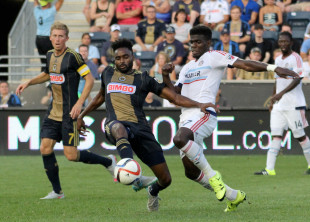

I don’t know what I would do if we win. 3 wins in a row, 9 points in 4 games. I’d probably cry.
I am very anxious to see Nogueira back on the field, but I agree that this may not be the time. Of the upcoming games, this is likely to be the most winnable. Let him get healthy, and maybe bring him on at the 60′ mark to get some match fitness. But this is not the time to get the best players hurt with big games coming up.
I was actually thinking the same thing about Barnetta, bring him on as a 2nd half sub to get some minutes. Of course, that didn’t work out so well last year in his first game with the U…
“Hey! Tranquillo! #$@% someone up!”
Would Paunovic ever consider one of his three centerbacks driving forward into the middle channel of the middle third to provide an outlet when pinned against one sideline or the other?
.
Seems to me, Cann sensei, if you are in possession, keeping three field players out of the attack is a real disadvantage.
@OSC – This is a great point. And I would answer yes, in some of the deeper positions that Brian Carroll takes up for the Union. It’s pretty hard to say, since Chicago has not spent much time both on the ball and moving forward at the same time, but I agree with you that, numerically, it’s *probably* beneficial to have the near-side CB push forward. Probably because of the caveat below.
–
A 3-5-2 team can stretch the field to an extreme degree (both horizontally and vertically), and recycling play deeper than normal is likely to be a feature rather than a problem. If the wide CBs stay too high, it’s more difficult for them to attack the space on the dribble, which is where they’re going to be most effective. So to an extent, sacrificing the extra man going forward is really about rethinking what it means to hold sustained pressure. If you’re good enough, you can cycle the ball out deeper and it’ll look like pressure is lifting when it really isn’t. That’s far from a clear answer, but I wanted to get it into the discussion before I’m away from a computer for the rest of the day!
If Nogs and Barnetta are ready to go then they need to be in the starting XI. This is a conference game against a team struggling to find itself. We must go for 3 points. The next game is not on short rest as it is on Friday, and is at home. I am not suggesting both Nogs and Barnetta need to go 90 mins, but we should be aggressive the next two games. The squad rotation game is in two weeks when the U travels to Seattle…a non-conference opponent.
It’s a good point but the lineup from NE should be more than suitable with Noggy and Barny coming off the bench. I’m envisioning the same XI with those two coming in and forcing the issue. It’ll be a stale match and then we’ll shift into a higher gear with super subs.
.
That being said, this 3-back system is a whole different animal. Going to be interesting.
I’m so ambivalent about the nickname Barney! But when I’m tired, it’s absolutely hilarious.
When he scores, do we sing “You are special, you’re the only one of you”?
I do not expect Barnetta to start on grounds of match fitness. The last information of which I know, he went 60 against Montreal the morning of the last televised preseason game in Florida. That’s six weeks ago.
.
And Curtin’s comments yesterday about Nogueira’s ankle suggests caution in his case as well.
.
if both players make the trip, they might get 20-30 minutes off the bench. Alberg and Ilsinho have yet to make a full 90.
Yeah you can pretty much pencil in 2 subs being made in the middle of the park. Between those 4 players (alberg, ilsinho, barnetta, Nogueira) it’s likely none can go 90. Even with ilsinho deployed out wide, it’s a bit tactically constraining to know going in you’re burning subs at a certain point. Maybe start one of the two, keep the flexibility and leave at least creavalle out there.
And barring injury, midfield is where you probably want to make your subs since those guys to the most running and the Union have the most depth there.
2nd this.
I think we run Barnetta out for the first 45 and Nogs for the first 70. It seems from reports that fitness seems to be a bigger issue for Barnetta than Nogs. Treat it as a trial to get our projected best XI on the field at the same time.
.
Pending the scoreline at half we can sub in Alberg/BC/LeToux. I think it’d be clear which sub would come on for which scenario.
.
I don’t know that I drop gaddis from 18, he is our only depth at wide for the back 4. I think it would have to be Leo or Le Toux(only from a busy schedule perspective). This seems like the hardest decision to make this weekend.
I will also say when Edu comes back BC drops from the 18. There, I said it.
projected 50 m.p.h. winds……
Crosses and switches will be a blast for a half.
Not to mention the serious knuckling on hard-driven shots.
.
Not an easy game for the keepers.
I’m not sure how we can go in with that 18. There is no defensive cover. If Nogs is available he needs to start. He’s done nothing to make himself sit. I’d take a more
Cautious approach with Barnetta. I’m not sure why everyone is getting to high on Carroll. Even in the two wins its not like he had monster games. Let him come in late to finish up, we need the best players starting the game.
Crevalle can move to right back and Andersen can play left back.
Le Toux can also play right back. So there are emergency answers available there for sure.
I mean I get the concept, but why take a chance when there are 6 subs and a goalie, we don’t need 5-6 to be offensive.
Curtin doesn’t usually switch the starters coming off a decisive win. I would imagine he would ease player coming off of injury back into the lineup at the end of the game.
Agreed. Based on his history, that’s the most likely scenario. But once he gets them 20-30 minutes of live game action, he’ll be ok moving them into the starting lineup next week, if they have outplayed the other guys.
.
I make that last statement mainly with Creavalle in mind, considering how well he’s played.
Any possibility of a different line-up for the Union to try to break their defensive stance? I heard Jim mentioned a 3-5-2 himself in the last week or two. What is the best formation for attacking a defensive 3-5-2?